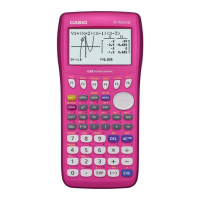This can also be done in GRAPH mode by storing each of the functions,
namely f(x), f´(x) and f´´(x) in the Y1, Y2 and Y3 ‘spaces’ respectively.
[Remember to place the ,X) after the rst and second derivative.]
Example
Find the integral of y = x
2
- 1 between x = 2 and x = 4. Result
Integral value only
OPTN
F4
F4
X,
θ
,T
x
2
-
1
,
2
,
4
)
then
EXE
Example cont.
Drawing the function f(x) = (x-2)e
X
and its rst and second derivatives.
Comment on the relationships between the graphs drawn.
Result
Enter the function
SHIFT
F4
[SKTCH]
F5
[GRPH]
F1
[Y=]
(
X,
θ
,T
-
2
)
SHIFT
In
X,
θ
,T
SHIFT
VARS
F6
F5
Enter the rst derivative
SHIFT
F4
[SKTCH]
F5
[GRPH]
F1
[Y=]
OPTN
F4
F2
(
X,
θ
,T
-
2
)
SHIFT
In
X,
θ
,T
,
X,
θ
,T
)
SHIFT
VARS
F6
F5
Enter the second derivative
SHIFT
F4
[SKTCH]
F5
[GRPH]
F1
[Y=]
OPTN
F4
F3
(
X,
θ
,T
-
2
)
SHIFT
In
X,
θ
,T
,
X,
θ
,T
)
SHIFT
VARS
F6
F5
then
EXE
cont. on next page
Differentation [in RUN-MAT] cont.
Integration [in RUN-MAT]
Integration can be displayed as the denite integral value only or the graph of the required integral and the denite
integral value. The calculator uses Simpsons Rule to evaluate denite integrals. If you do not specify the number of
steps used by Simpsons Rule, then the calculator will use 512 steps in the calculation of the request.

